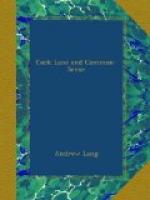This uniformity, to a certain extent, is not surprising, for savage, classical, and modern spiritualism all repose on the primaeval animistic hypothesis as their metaphysical foundation. The origin of this hypothesis—namely, that disembodied intelligences exist and are active—is explained by anthropologists as the result of early reasonings on life, death, sleep, dreams, trances, shadows, the phenomena of epilepsy, and the illusions of starvation. This scientific theory is, in itself, unimpeachable; normal phenomena, psychological and physical, might suggest most of the animistic beliefs. {35}
At the same time ‘veridical hallucinations,’ if there are any, and clairvoyance, if there is such a thing, would do much to originate and confirm the animistic opinions. Meanwhile, the extraordinary similarity of savage and classical spiritualistic rites, with the corresponding similarity of alleged modern phenomena, raises problems which it is more easy to state than to solve. For example, such occurrences as ‘rappings,’ as the movement of untouched objects, as the lights of the seance room, are all easily feigned. But that ignorant modern knaves should feign precisely the same raps, lights, and movements as the most remote and unsophisticated barbarians, and as the educated Platonists of the fourth century after Christ, and that many of the other phenomena should be identical in each case, is certainly noteworthy. This kind of folklore is the most persistent, the most apt to revive, and the most uniform. We have to decide between the theories of independent invention; of transmission, borrowing, and secular tradition; and of a substratum of actual fact.
Thus, either the rite of binding the sorcerer was invented, for no obvious reason, in a given place, and thence reached the Australian blacks, the Eskimo, the Dene Hareskins, the Davenport Brothers, and the Neoplatonists; or it was independently evolved in each of several remote regions; or it was found to have some actual effect— what we cannot guess—on persons entranced. We are hampered by not knowing, in our comparatively rational state of development, what strange things it is natural for a savage to invent. That spirits should knock and rap seems to us about as improbable an idea as could well occur to the fancy. Were we inventing a form for a spirit’s manifestations to take, we never should invent that. But what a savage might think an appropriate invention we do not know. Meanwhile we have the mediaeval and later tales of rapping, some of which, to be frank, have never been satisfactorily accounted for on any theory. But, on the other hand, each of us might readily invent another common ’manifestation’—the wind which is said to accompany the spirit.




